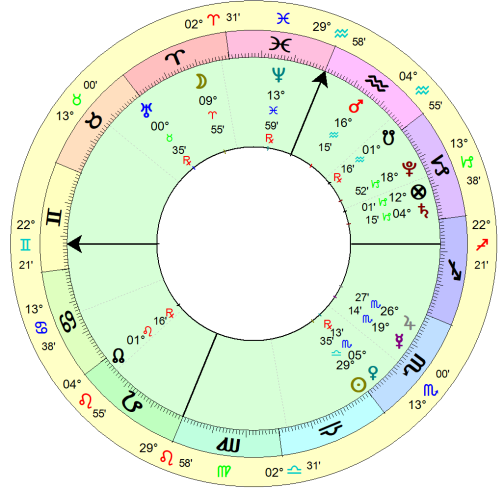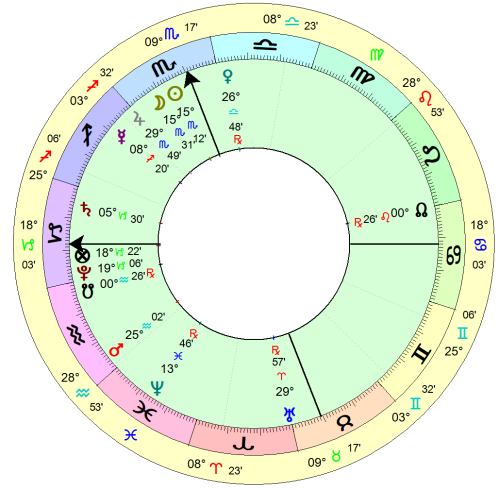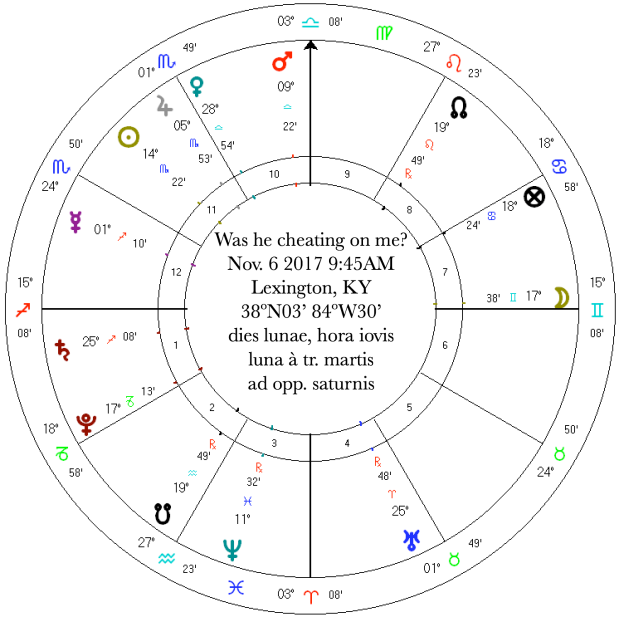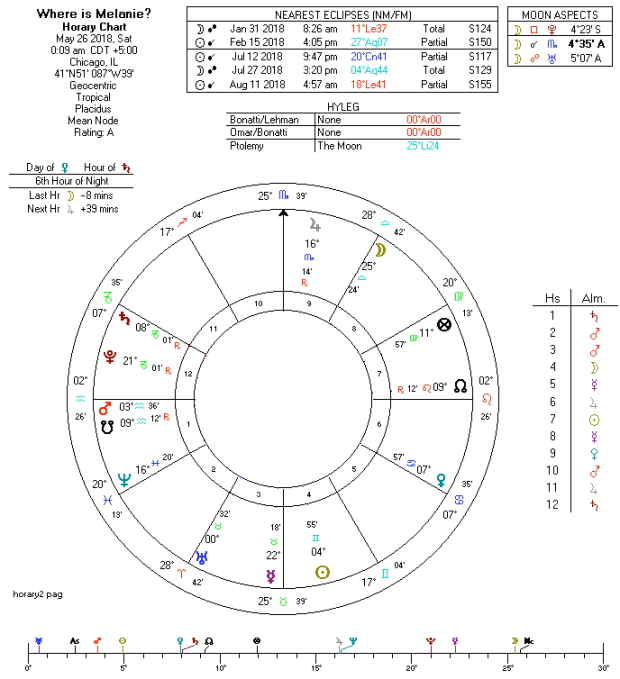I’ve wanted to write this chart up for a while because it’s not a horary with a super sexy happy ending like some of the other ones I’ve written up. That said, it is a stupendous example of horary “working.”
It’s awesome when horary gives you a satisfying resolution, but I’ve discovered that part of the power in this art is found when the chart gives you a negative answer.
This is the magic moment where horary transitions from being a neat astrological lifehack to becoming a therapeutic intervention. Several charts have come across my laptop where people have been wondering whether a person would recover from an illness or not, or whether a treasured item would be recovered. Not all of them have been positive.
When delivering a negative answer to these questions, the astrologer’s role as a technical wizard diminishes. Circumstance asks them to become a chaplain for their client in that moment, with a non-anxious presence large enough and strong enough to hold the client’s experience of loss and to empathize with them. Anyone studying astrology with the goal of helping people needs to grapple with this—particularly people studying horary. That said, being able to sit with people in their grief is an essential skill of being human, and tragically it’s a skill that not a lot of people have.
Yikes, this is a bit of a downer, isn’t it?
But it’s crucial that anyone in helping fields be able to go to these places. It’s doubly important for astrologers to get the symbolism in their judgment correct without trying to engineer a positive answer out of a negative situation. To give you an example of a chart like this, I want to share the chart of a question I asked on my own behalf.
On the morning of the last day of the SOTA conference in Buffalo this past fall, I got a text message from my mom saying that my grandma (my dad’s mother) had fallen and broken her hip. I’ve been around long enough to know that complications from falls are one of the primary causes of death for elderly people after a certain age, and my grandmother had just turned 92.
When I got the text the grief-wave immediately began yanking on my solar plexus, so I excused myself to the restroom to cry. I had the thought to draw a chart at that moment to ask whether she would recover but I determined that I needed to sit on it before asking the question.
Bonatti writes:
The 2nd consideration is (what we hinted at before) the method or manner everyone ought to observe that enquires of an Astrologer; which is, that when he intends to take an artist’s judgment of things past, present, or to come, he should, first, with a devout spirit, pray unto the Lord, from whom proceeds the success of every lawful enterprise, that he would grant him the knowledge of those things of the truth of which he would be resolved; and then let him apply himself to the astrologer with a serious intent of being satisfied in some certain and particular doubt, and this not on trifling occasions, or light sudden emotions, much less on matters base or unlawful, as many ignorant people used to do; but in matters of honest importance, and such as have possessed and disturbed his mind for the space of a day and night or longer; unless in sudden accidents which admit not of delay.
– Guido Bonatti, 146 Considerations as translated by William Lilly
So, I sat on it all day.
When my flight began its descent into Lexington later that night, I determined that I had thought about the question long enough to be able to ask it and draw the chart. And namely, I realized that I was prepared to accept a “no” answer, which was the crucial moment. The moment when you feel in your bones that you’re ready to accept whatever the chart has to offer is the moment that it’s right to ask a question.

Will grandma recover? – 22 October 2018, 9:40pm, Lexington, KY
The very first thing I noticed in the chart was that the ascendant degree of the horary chart was conjoined my dad’s natal ascendant degree and his Jupiter. Considering this was my dad’s mom I was asking about, that confirmed that the question was asked at precisely the right time; I’m not a walking ephemeris, so I couldn’t have planned that any better.
The next problem in this is assigning the significators here. Since this is a question about someone absent, “whether they live or die” as Lilly would say it, we can take the ascendant, its ruler, and the Moon as significators. In my estimation I think there’s also an argument that we can use the ruler of the 4th as a general significator for ancestry here, since my grandma was my last living grandparent at the time. But the Sun is also important as the significator of legacy here, what some texts refer to as “the end of the matter.” I try to avoid that phrase because often it’s a red herring, but when we’re looking at charts with this kind of gravity, it becomes important.
So in this case we’ll take Mercury and the Moon as my grandma’s primary significators, as well as the Sun as the 4th ruler for an additional component of the story (and you’ll see why this becomes important).
Before we jump into judging significators, let’s look quickly at the angles to see if there are any planets or prominent fixed stars that we need to draw into the interpretation. I see immediately that Saturn is strong in the 7th as the 8th and 9th ruler. Even though he’s not directly related to the question in terms of signification, his position here is coloring the outcome. Consider what “recovery” means: it means that my grandma will continue living forward. With Saturn in the 7th here, forward motion is stymied. We’re not off to a great start here.
Sidebar: yes, I’m aware that Saturn in 7 is a consideration prior to judgment. Whenever I see it, the story it tells is one of “don’t get your hopes up;” he calls for aggressive realism, and where astrologers go awry is usually when they try to engineer a positive answer despite Saturn in 7.
Now to the significators: the ascendant ruler Mercury is placed at 19 Scorpio 14 in the 6th house, moving towards a conjunction with Jupiter. The application to Jupiter is promising—it’s within Jupiter’s orb, moving fast, but my concern is that both planets are cadent, and Jupiter is peregrine. Being in Scorpio, this is a Jupiter who will probably promise quite a bit that they can’t follow through on, and since Jupiter is the 7th ruler here, he signifies the medical team caring for my grandma.
Likewise, because of Mercury’s placement in a moist sign (Scorpio) and in the 6th house, separating from the square of Mars in Aquarius (an air sign), there’s a solid indication that pneumonia (or something like it) is within the realm of possibilities.
Finally we turn to the Moon, in Aries in the 11th house: she separates from the square of the 8th ruler Saturn and applies to the sextile of Mars with reception. Again, Mars is the 6th ruler here, so this by and large a negative indication. Because of the Moon’s placement in the 11th house, there’s certainly hope of recovery, but the next contact is to a malefic, after which she opposes the Sun. Symbolically, hard aspects between the Moon and the Sun are typically indicators of damage or otherwise challenging circumstances.
Remember what I said about the Sun being the 4th ruler: not only does it rule the concept of ancestry here, it also rules the concept of legacy and the story that will be told as this chart unfolds. It also rules the grave.
We’ve got a clear story here: the promise of recovery frustrated, illness sets in, and she will die. Because the Moon passes 20 degrees until its opposition with the Sun, I surmised she would likely pass within 20 days.
As it happened, grandma died 16 days later. Look at the Moon here.

Grandma died – 7 November 2018, 11:38am, Burlington, NC
It’s quite stunning; she passed away in the very moments in which the Moon conjoined the Sun, and while the horary 8th house cusp was passing over the ascendant, drawing together the most powerful indications in the horary chart in a real-time transit.
Astrologers start to develop weird grief processes after a certain point, I think. If something tragic is affirmed by a chart, whether it’s a horary chart or a weird transit or direction happening in someone’s nativity, we’ll sometimes go to astrology as a buffer against our feelings.
The power, though, is in allowing ourselves to sink into the reality that we, and all those we love, are buoyed up in a story that has its origin and its ending in the cosmos. The gift of blessed perspective can assist us, and those we serve, in expanding our souls enough to contain our grief as those stories become woven into the fabric of who we are. And we, in turn, move in more subtle sync with the Love that moves the Sun and other stars.
featured image by Joy Real via Unsplash










